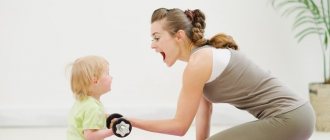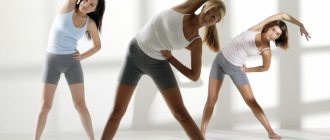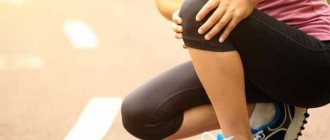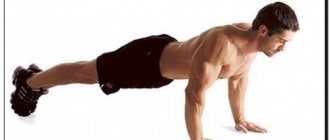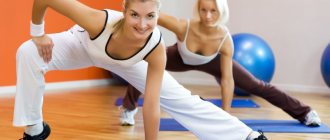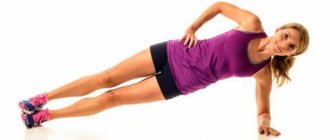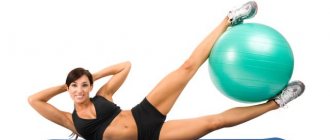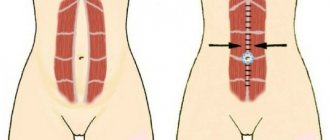What could be easier than breathing. People rarely think about the fact that this process has its own rules and special techniques that can radically affect a person’s health, well-being and performance.
But experienced athletes, coaches and specialists in the field of sports medicine know this very well.
That is why during any training much attention is paid to the breathing aspects.
Breathe correctly during training
Strong movement with good amplitude is only possible if the spine is rigid. It, in turn, can only be strengthened by tensing the core muscles, or rather the muscles of the back, abdomen and pelvic floor.
When inhaling, it is impossible to transfer tension to the press, and therefore to ensure the rigidity of the axial part of the skeleton.
But at the moment of exhalation, this is quite simple to implement. This is due to the reflex action of the nervous system. Thanks to the tension that is transmitted to the muscles, the spine is fixed, allowing the athlete to work at full strength. Simply put, exhalation is performed for effort, and inhalation is performed for the least energy-consuming part of the exercise.
Often, when the peak point of an element is reached, the breath is held. Many bodybuilders and bodybuilders use this feature in their training to pump up using large weights. This technique is called the Valsalva maneuver. However, working in this mode is unsafe, and only the most experienced athletes can afford it.
Important! Another nuance of breathing during physical activity is related to air intake. Inhalation at the moment of minimal muscle effort is carried out through the nose, while exhalation is carried out through the mouth. This is an important rule to remember when training.
Be sure to check out:
Gallery image with caption: Basic exercises for all muscle groups: a strong and strong body at home Gallery image with caption: Jumping on a trampoline: effective for weight loss Gallery image with caption: How to maintain excellent physical shape after 40 years: choosing exercises Gallery image with caption: Exercises for muscles and the whole body
General recommendations for performing exercises
The trick is that these are not just physical exercises, although outwardly they may look like that. Day after day we make the same movements, which involve the same muscles and joints. The meaning of Sufi restorative exercises is that they make up for the lack of general activity. When performing them, you must comply with a number of conditions. First, you need to be aware of what you are doing. With awareness, you pay positive attention, that is, good feelings, to one or another part of the body. Positive, good energy is directed where your attention is directed. That is why traditional gymnastics, during which your thoughts are wandering God knows where, brings little benefit and sometimes even harm. If someone is doing a series of squats and at the same time is thinking about a quarrel with co-workers at work, then where does all the negative, bad energy go? That's right, in the ankle joint. And then we wonder why I’m training and training my legs, or maybe a slight sprain, or a sore meniscus, or something worse. So, by being aware of the sensations of the body, we thus get to know our own body better, and on the other hand, we harmonize its activities with the help of a positive attitude. There is no need to repeat the same sequence of movements every day: change the order, following your intuition!
Secondly, we follow the rule: “Tension is on inhalation, and relaxation is on exhalation.” If this rule is violated, the activity of the body, on the contrary, is even more upset and disrupted. When we inhale, we mobilize the body, and when we exhale, we provide optimal relaxation. Tension involves all muscle groups, not just those directly associated with performing a specific exercise.
Energy has the property of pulsation. Everything around is pulsating: breathing, knocking, compressing and unclenching. Self-healing is also based on the principle of recreating free pulsation. If free pulsation for some reason turns out to be impossible (energy “blockages”), then problems arise. It's like a cell phone that only works on reception. You have received information, but cannot send it: the signal does not “go through”. By performing certain exercises, you stimulate pulsation, but this requires patience, endurance, in a word, discipline.
One course participant complained of pain in his hand: he could not work on a computer or drive a car. By regularly performing simple exercises of squeezing and unclenching his fingers, he restored the flow of energy, and soon his hand began to work.
Thirdly, each time you perform the exercises, you need to note changes, improvements, be aware that now you are raising your body one and a half to two centimeters higher than yesterday, that out of ten times you can do five push-ups, not zero from the floor.
Fourth, focus on exercises that involve those zones (dhikrs) in which you have problems, that is, “sores”, negative manifestations of nafs. We send them as much positive energy as possible.
And most importantly, before exercise, create a good mood, evoke gratitude to all of God’s world, remember something beautiful, pleasant, filling you with energy. Be creative! There were many joys and pleasures in your life. We forbid you to say that you did not have them. There is no need to lie, at least to yourself. Sufis call this positive state the term mukashafa, which can be translated as anticipation of discovery. In this state a person is whole. Having achieved integrity, he begins the path to healing, to a full, fruitful life.
If you don’t follow these conditions, then it’s better to continue sleeping. There are already so many “obligations” in your life. Why add another one?
Exercises can be performed to music. I especially recommend this to older people. It is through it that they more easily achieve the purifying state of mukashaf. But if you're someone who has trouble concentrating (or if you're under 21), then God bless the music. Work for nothing.
Certain aromas also improve your mood for exercise. The smell of musk and essential oils contributes to entering the mukashafa state. Sufis have been selecting these scents for centuries.
The main criterion for the effectiveness of exercises is a feeling of pleasant fatigue (some people try to feel pleasant fatigue after the first exercise - this is self-deception!). The tension should be extreme, but we should not bring it to the point of pain or unpleasant sensations.
Attention!!! If you want to get the most benefit from exercise, then follow the following sequence. First, carefully read the descriptions of the exercises, trying to perform individual movements as you read. Then try the exercise without the help of text. After this, perform the exercise, bringing it to automaticity (but this does not mean that you will perform the exercise mechanically, without thinking about every breath!). And after a while, look at the text again, did you do everything right? Be scrupulous and thorough here. Achieve the most accurate execution possible. Re-read and do until you feel like your body has remembered this exercise. Next, exercise for your health.
Want to know what time of day you can get the most benefit from exercise? Remember what time you were born and add 8 hours to it. If you were born at 3 pm, then the best time to exercise is 11 pm. If you were born at 2 am, then 10 am is exactly your time! Some may ask: “What if the exercise time occurs at night?” Well, get up at night and do some exercise. If this is impossible for you, you are accustomed to the fact that night is not the time when you can do anything at all, then in the morning, after sunrise.
If you have a busy life schedule and find it difficult to find time for exercise, then do it in the morning, five times a week. As for the optimal time of day for you (hour of birth + 8 hours), then at this time (+ 1 hour) find a few minutes for breathing exercises. It is advisable that the time and place of exercise remain the same. If you often change your place of residence, then before starting exercises in a new place, give yourself a feeling of familiar surroundings.
For those who do not know the time of their birth and have no way of finding out, it is worth trying to do the exercises at different times of the day for a week. It is also recommended to remember at what time of the day you usually feel the most activity, a surge of energy, and a desire to act.
https://youtu.be/H7p_vx3BVp0
Why is this so important
Breathing techniques are important during sports for several reasons:
- with the wrong “way” of breathing, the effectiveness of any training decreases;
- when holding your breath while lifting a heavy weight, intra-abdominal and blood pressure increases, which has a detrimental effect on the functioning of systems and organs such as the kidneys, heart, blood vessels, brain and eyes;
- Unjustified holding of breath can lead to oxygen starvation, which results in severe dizziness and loss of consciousness.
Breathing technique is no less important for girls working on a slim figure. Deep breathing allows you to increase oxygen supply to cells and speed up metabolism, which will affect the rate of adipocyte breakdown. Good breathing technique increases endurance and reduces fatigue.
What movements help restore breathing rhythm after exercise?
The simplest movement algorithm will help restore breathing after physical activity:
- while inhaling, rise on your toes and stretch upward;
- As you exhale, lower your body down, hanging your arms freely.
You can repeat this 3 to 5 times.
This breathing exercise is effective for several reasons:
- when stretching, the lungs accommodate an increased volume of air;
- During the bending process, the abdominal muscles push out more carbon dioxide.
As a result, the heart requires less effort to remove this byproduct from the body, and the pulse and heart rate stabilize faster. In addition, the tilt gives the brain a kind of signal about the end of the workout and the need to relax, which engages the nervous system, which launches the recovery program.
Breathing exercises for school-aged children
These exercises are designed for children under 15 years of age with lung problems, but breathing exercises also work well for adults. After several days of training, you will notice that you have become calmer, your sleep has improved, and a forgotten glow has appeared on your face. Perform each exercise 5 times.
- Inhale through your nose, exhale through your mouth, and at the same time, as if pronouncing the letter Sh, Z, E, etc.
- Inhale through the tube, exhale through the mouth.
- Close one half of the nose, inhale and release air through the free nostril. Repeat with the other half.
- We inhale through the nose, make a tube out of the lips and exhale slowly.
- Hands on the waist, when inhaling, you need to inflate your stomach. And on the way out, on the contrary, pull your stomach in.
- Close your hands above your head, stand on your tiptoes, and inhale. Then lower your hands, as if chopping wood, exhale.
- As we inhale, we raise our shoulders, as we exhale, we lower them and say “kha.”
Effective gymnastics for the diaphragm
Deep breathing is primarily breathing from the diaphragm. To improve technique, it is necessary to develop this type of muscle tissue. As you know, you can pump up your muscles with exercise. The diaphragm was no exception. To strengthen it, it is necessary to regularly perform the following elements:
- Boat (classic).
Technique:
- lie with your back on the floor, legs extended and arms along your body;
- simultaneously raise the upper torso and legs 10-15 cm from the surface;
- try to touch your knees with your hands;
- stay for the maximum amount of time;
- return to IP.
This exercise strengthens not only the diaphragm, but also the abdominal muscles, while simultaneously influencing the functioning of the internal organs. You should start doing it 1-2 times, gradually increasing to 10-12.
- Grasshopper.
Technique:
- lie on your stomach with your legs extended and your arms along your body, clench your fists;
- while inhaling, place clenched fists under the lower abdominal area and hold your breath;
- lift your legs off the floor without separating them, and lift them as high as possible, leaning on your fists;
- exhale and return to IP;
- relax.
Beginners can move their legs alternately. Just like with the “boat”, you should start with 1 repetition, gradually progressing to 10-12.
Breathing exercises for stress and nerves
Sit comfortably on a chair. The back is straight. Hands on knees. Inhale at a medium pace and exhale very slowly; as you exhale, relax your facial muscles and smile. You can do up to 20 repetitions.
To normalize heart rate. Inhale – 1-2. Start breathing from the stomach and then through the chest - 3-4. Exhale – 5. Pause – 1-5. Repeat several times.
Check your pulse and compare how many heartbeats it takes for 1 inhalation and 1 exhalation. Slowly increase your exhalations - 1 pulse beat longer. Deep breathing will cause your heart rate to slow down.
Anti-stress. Lying on your back, bend your knees and pull them to your chest, clasping them with your arms. Press your chin to your chest. Breathe with your belly moving smoothly. Rocking gently from side to side, coordinate your breathing. Inhale - swing to the right, exhale - starting position. Inhale - to the left, exhale - starting position. Once you feel relaxed, you can straighten your body. Try to increase the time for performing this exercise up to 30-40 times.
And finally, unique breathing exercises from Mirzakarim Sanakulovich Norbekov, if you master these simple exercises, tell us about the effect. Write, comment, I will wait for your feedback.
Recommendations from professionals
Ekaterina Usmanova, Russian fitness bikini champion, video blogger
Ekaterina recommends paying special attention to breathing techniques when implementing weight loss complexes. Getting flat abs without deep breathing, says the video blogger, is very difficult.
Evgeny Smychkov, sports expert
A video trainer on one of the morning television programs pays great attention to the importance of proper breathing during strength training. An incorrect breathing technique, the expert warns, is primarily a blow to the heart muscle.
Stuart McRobert, bodybuilder, writer and publicist in the field of strength sports
A real “revolutionary” from bodybuilding writes in his works: “... you should not hold your breath at the moment of a jerk or when the critical point of the load is reached. On the contrary, you should exhale as much as possible, otherwise it will lead to a temporary “shutdown” of an organ such as the brain, or a sharp increase in blood pressure.”
Recuperation after training
The main factor for full recovery after training is rest. In this case, most athletes only need 1-2 days without physical activity. At this time, it is important to eat a nutritious diet, drink the required amount of water, and maintain a sleep schedule. To make the process of replenishing strength easier and faster, it is important to finish the workout correctly. You can't do this abruptly. The training should end with a cool-down, i.e. loads in the form of stretching the upper and lower body or light cardio.
Main conclusions
Breathing technique is what beginners who are just starting to train at home or in the gym should learn first:
- Breathing technique is, first of all, working with the diaphragm.
- To increase the productivity of training, inhale at minimum effort and exhale at maximum effort.
- Untimely holding your breath can lead to unnecessary stress on the cardiovascular system.
- Stretching and bending along with inhalation and exhalation can restore breathing and help the body relax.
The diaphragm is a muscle, which means it can be worked. The simplest exercises will strengthen it and significantly increase pumping efficiency, endurance and strength.
Some useful theory
The human body is a self-sustaining and self-healing system. These two concepts are related. There is a certain point of balance when all processes inside the body proceed at a normal pace (homeostasis, it’s called). For example, this is a state of rest. When a person begins to actively train, his body uses all its reserves to ensure the same normal stable state, but during the training process. After exercise, the body restores the same reserves spent on physical work.
It restores the original biochemical, physiological and anatomical state that was before the load. Therefore, in order to understand how to restore strength after exercise, it is important to know what the body needs to renew spent resources. In particular, one of the necessary elements is healthy sleep.
Nature has provided for everything, including the body’s ability to adapt to heavy physical work. Training to the limit (or as athletes say, “to failure”) activates this same adaptation process in our body, which is expressed in muscle growth. This is the body's natural preparation to overcome more severe stress.
All types of training are based on the process of adaptation of the body to increasing loads. Both for the growth of muscle mass and for increasing strength or endurance. The body's capabilities increase during the recovery period.
Now you understand that improper recovery will lead to a lack of desired progress. And believe me, no one wants to train to no avail, or even worse, to the detriment of health.
https://youtu.be/x9szz8i4s6Y
Normal and maximum heart rate during physical activity
Clinical examination
(life history, sports history, examination, palpation, auscultation, measurement of blood pressure and heart rate).
Anthropometric examination
(height, body weight, waist circumference, vital capacity, measurement of the fat component).
Functional examination
(physical exercise tolerance, functional class) Additional examinations of the patient are necessary in case of: deterioration of health and after breaks in activities due to illness. You should not exercise during an acute illness, including a cold, or during an exacerbation of a chronic illness. When resuming classes, it is recommended to reduce the usual loads by half and gradually bring them to the previously achieved level.
During physical activity, your pulse must first be monitored before training. The pulse rate during physical activity 10 minutes after completion may be 10-25% higher than the initial one (for example, before training - 72 beats/min; after - 90 beats/min, that is, 25% more). For older and untrained people, the maximum heart rate during physical activity can be 10 - 14 beats per minute higher than the initial data.
"Speaking test" during physical activity:
- you can speak freely - increase the intensity;
- speak briefly, inhaling deeply between phrases - this load corresponds to your functional status;
- being able to say only 1-2 words, and then having difficulty catching your breath - obvious overexertion.
The pulse is counted in the morning while lying in bed at rest. Normally, daily pulse fluctuations do not exceed 2-5 beats/min. If pulse fluctuations are inconsistent and exceed this value, then the body is chronically overworked.
Orthostatic test.
The pulse is counted first in the supine position, then 1 minute after rising. With good adaptation, the difference in normal heart rate during physical activity should not exceed 8 - 10 beats/min. A difference of 15-20 strokes is satisfactory; >20 is a sign of overtraining, or detraining, or dysregulation of the autonomic nervous system.
Normal, sound sleep, good health and mood are indicators of correctly selected training intensity.
